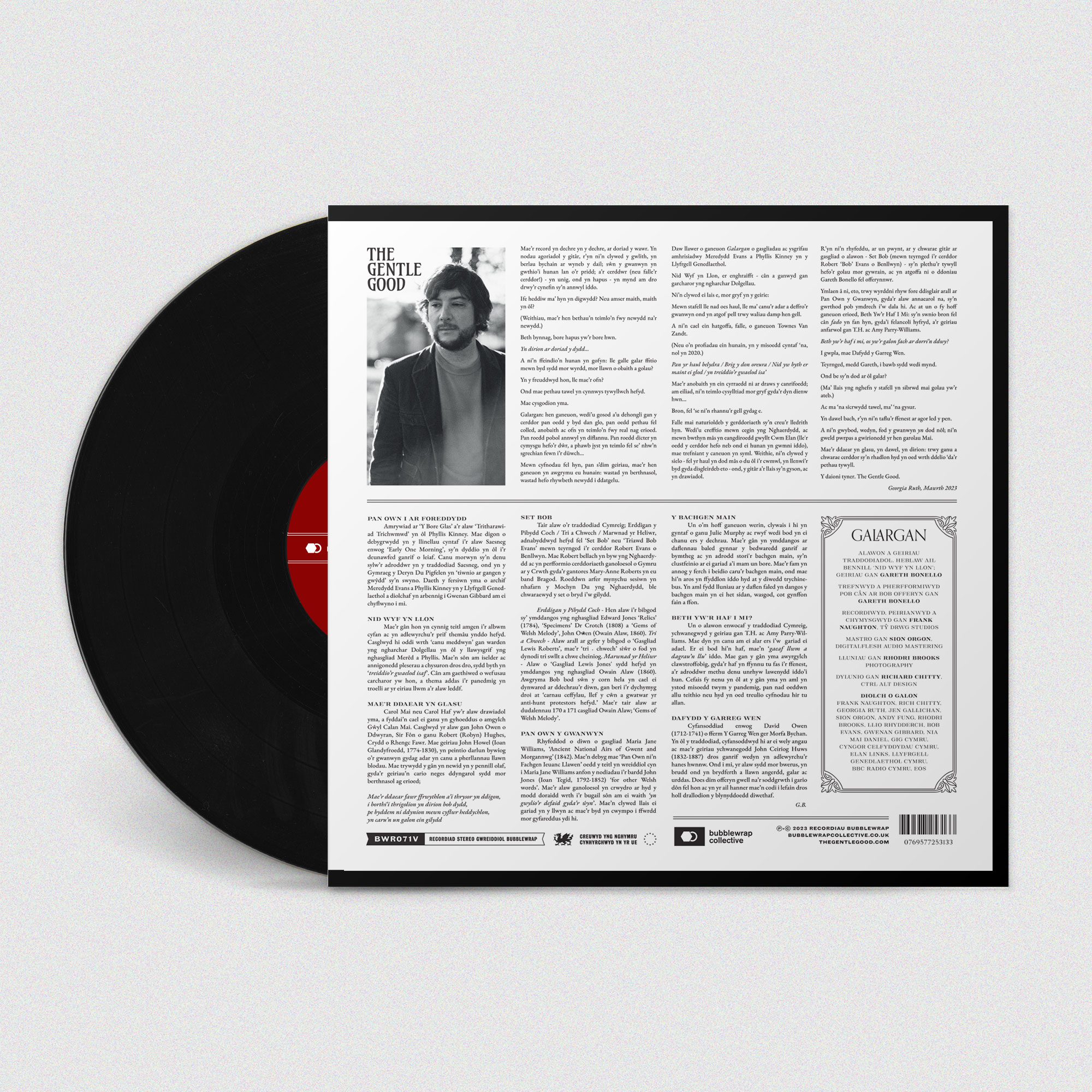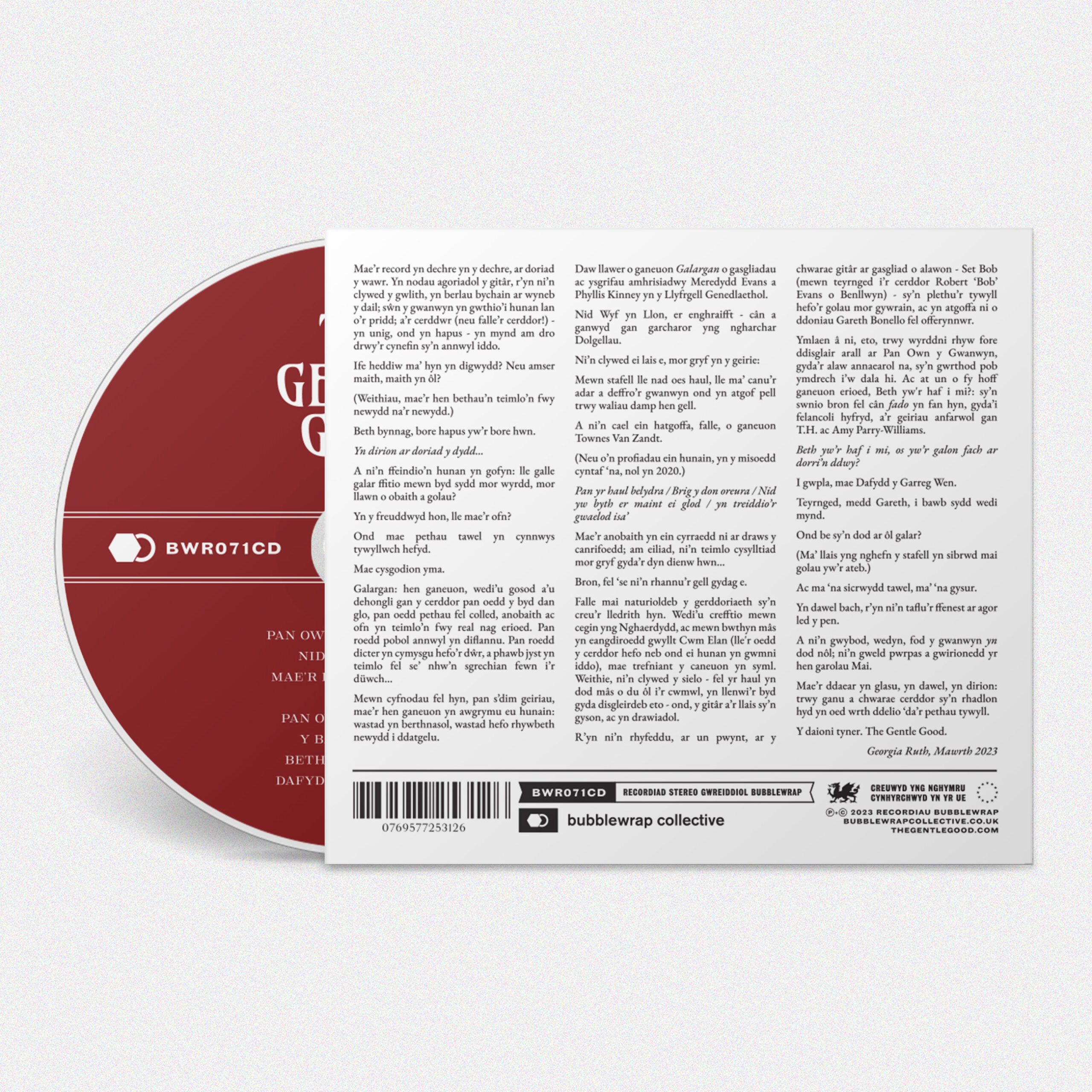GALARGAN
The record begins in the beginning, at dawn. In the opening notes of the guitar, we hear the dew in small pearls on the surface of the leaves; the sound of spring pushing itself up from the soil; and the walker (or maybe the singer!) – alone, but happy – going for a walk through the land that is dear to him.
Is it today this is happening? Or a long, long time ago?
(Sometimes, the old things feel newer than the new.)
Anyway, this morning is a happy morning.
Tender at the break of day…
And we find ourselves asking: where could there be grief in a world that is so green, so full of hope and light?
In this dream, where is the fear?
But silent things also contain darkness.
There are shadows here.
Galargan: old songs, set and performed by the musician when the world was locked, when things like loss, despair and fear were felt more than ever. When loved ones disappeared. When anger was mixed in the water, and people just felt like they were screaming into the void…
At times like this, when there are no words, the old songs suggest themselves; always relevant, always with something new to impart.
Many of Galargan’s songs come from Meredydd Evans and Phyllis Kinney’s invaluable archive and writings in the National Library of Wales.
Nid wyf yn llon, for example – a song sung by a prisoner in Dolgellau prison.
We hear his voice, so strong in the words:
In a room where there is no sun, where the singing of the birds and the awakening of spring is only a distant memory through the damp dampness of an old cell.
And we are reminded, perhaps, of the music of Townes Van Zandt.
(Or of our own experiences, in those first months of 2020.)
When the sun shines / The top of the golden wave / It never for all its glory / Penetrates the deepest depths
The hopelessness reaches us across the centuries; for a moment, we feel such a strong connection with this nameless man…
Almost, like we share the cell with him.
Perhaps it is the naturalness of the music that weaves this spell. Crafted in a kitchen in Cardiff and in a cottage in the wild lands of Cwm Elan (where the musician had no-one but himself for company), the songs are simply arranged. Sometimes, we hear the cello – like the sun emerging from behind the cloud, filling the world with brightness once more – but it’s the guitar and voice that are constant, and striking.
We marvel at one point at the guitar playing on a collection of tunes – Set Bob (in tribute to the musician Robert ‘Bob’ Evans from Penllwyn) – which weaves the dark with the light so elaborately and reminds us of Gareth Bonello’s talents as an instrumentalist.
On we go, again, through the green of another bright morning on Pan own y gwanwyn, with that unearthly melody, which refuses all efforts to define it. And to one of my favourite songs of all time, Beth yw’ r haf i mi? which sounds almost like a fado song here, with its lovely melancholy, and those immortal words by T.H. and Amy Parry-Williams.
What is summer to me when the little heart is about to break in two?
To close, there is Dafydd y Garreg Wen.
A tribute, says Gareth, to all those who have gone.
But what comes after grief?
(A voice at the back of the room whispers that the answer is light.)
And there is a quiet certainty, there is solace.
Quietly, we throw the window wide open.
And we know, then, that spring is coming back; we see the purpose and truth of those old May carols.
Mae’r ddaear yn glasu. The earth is greening, quietly, gently: by the singing and playing of a musician who is gracious even when dealing with the darkness.
The Gentle Good.
Georgia Ruth, March 2023
1. Pan own i ar foreddydd
A variation on ‘Y Bore Glas’ and the tune ‘Tritharawiad Trichwmwd’ according to Phyllis Kinney. There are plenty of similarities in the first lines to the famous English tune ‘Early One Morning’, which dates back to the eighteenth century at least. It is the singing of a maiden that attracts the narrator’s attention in the English tradition, but in Welsh it is the Blackbird ‘tuning on the branch’ that fascinates. This version came from the archive of Meredydd Evans and Phyllis Kinney at the National Library of Wales and I thank Gwenan Gibbard especially for sharing it with me.
2. Nid wyf yn llon
This song offers an alternative title for the whole album, reflecting as it does several pertinent themes. It was gathered ‘from the singing of a drunk’ by a warden in Dolgellau prison according to the manuscript in Merêd and Phyllis’s collection. It speaks of depression and the inadequacy of temporary comforts, which never reach the lowest depths. This is a song about being trapped from the lips of a prisoner, and a suitable theme for the pandemic as the melancholic melody revolves around the bleakness of his words.
3. Mae’r Ddaear yn glasu
This impressive tune is known as a May, or Summer Carol (Carol Mai/Carol Haf), which would be sung in public around the May Day Festival. The melody was collected by John Owen from Dwyran, Anglesey from the singing of Robert (Robyn) Hughes, a shoemaker from Rengc Fawr. The words of John Howel (Ioan Glandyfroedd, 1774-1830), paint a lively picture of spring with birds singing and orchards full of flowers. The course of the song changes in the last verse, with the words carrying a humanitarian message that is as relevant today as it ever was;
The great fertile earth and its treasure are enough,
to feed its inhabitants with plenty every day,
if only we men were in a peaceful state,
and coul love each other with one heart
4. Set Bob
Three tunes from the Welsh tradition; Erddigan y Pibydd Coch/Tri a Chwech/Marwnad yr Heliwr (The Red Piper’s Tune/Three and Six/The Hunter’s Lament) also known as ‘Set Bob’ or ‘Triawd Bob Evans’ in tribute to the musician Robert Evans from Penllwyn. Robert now lives in Cardiff and performs medieval music from Wales on the Crwth with the singer Mary-Anne Roberts in their band Bragod. I used to attend a session at the Mochyn Du pub in Cardiff, where the set would be played from time to time.
Erddigan y Pibydd Coch – An old piper tune that appears in Edward Jones’ collection ‘Relics’ (1784), Dr Crotch’s ‘Specimens’ (1808) and John Owen’s ‘Gems of Welsh Melody’ (Owain Alaw, 1860). Tri a Chwech – Another tune for the bagpipes from the ‘Lewis Roberts Collection’, the ‘three and six’ indicate three shillings and six pence. Marwnad yr Heliwr – A tune from the ‘Lewis Jones Collection’ which also appears in the Owain Alaw collection (1860). Bob suggests that the sound of the hunting horn is imitated at the beginning of the tune, causing the imagination to turn to ‘horses’ hooves, the voice of the dogs and derision of the anti-hunt protestors too. The three tunes are on pages 170 and 171 collections of Owain Alaw; ‘Gems of Welsh Melody’.
5. Pan own y gwanwyn
A wonderful tune from Maria Jane Williams’ collection, ‘Ancient National Airs of Gwent and Morgannwg’ (1842). Apparently ‘Pan Own ni’n Fachgen Ieuanc Llawen’ was originally the title before Maria Jane Williams sent the notes to the poet John Jones (Ioan Tegid, 1792-1852) ‘for other Welsh words’. The medieval melody wanders along the Dorian mode as the shepherd talks about his work ‘watching the sheep with the lambs’. He hears his lover’s voice nearby and he becomes so enraptured the world melts away.
6. Y Bachgen Main
One of my favorite folk songs, I first heard it from the singing of Julie Murphy and I have been performing it right from the start of my career. The song appears on early nineteenth century ballad sheets and tells the story of ‘y bachgen main’ (the slender lad), who eavesdrops on his girlfriend and her mother one morning. The mother does not approve of the match and tries to dissuade her daughter, but she remains loyal right up to the tragic end. Pictures on the ballad sheet will often show the slender boy in his silk hat, waistcoat, tailcoat and cane.
7. Beth yw’r haf i mi?
One of the most famous tunes in the Welsh tradition, the words were added by T.H. and Amy Parry-Williams. A man sings about his grief since his lover left him. Although it is summer, for him it is a ‘bleak winter full of tears’. This song has a claustrophobic atmosphere, with the summer flourishing just outside the window, and the narrator unable to take any joy for himself. I was often drawn back to this song during the hot months of the pandemic, when we were unable to travel or even leave the house.
8. Dafydd y Garreg Wen
A famous composition by David Owen (1712-1741) from Y Garreg Wen farm near Morfa Bychan. According to tradition, Owen called for his harp and composed the tune on his deathbed. The words were added by John Ceiriog Huws (1832-1887) over a century later and reflect the story. But for me, it is the melody that is so powerful; harsh yet beautiful and full of passion, grief and dignity. There is no better instrument than the cello to carry a tune like this and in the fading light it rises to cry for all the miseries of recent years.
Galar: Grief / Sorrow / Mourning
Cân: Song
*Pronounciation guide*
Galargan – GAL-ARE-GARN (GAL as in lady, ARE as in we ARE, GARN to rhyme with barn)
Traditional melodies arranged and performed by Gareth Bonello
Recorded, Engineered and Mixed by Frank Naughton, Tŷ Drwg Studios
Mastered by Sion Orgon, Digitalflesh Audio Mastering
Photos by Rhodri Brooks Photography
Design by Richard Chitty, Ctrl Alt Design
Thank you from the bottom of my heart – Frank Naughton, Rich Chitty, Georgia Ruth, Jen Gallichan, Sion Orgon, Andy Fung, Rhodri Brooks, Llio Rhydderch, Bob Evans, Gwenan Gibbard, Nia Mai Daniel, NHS Wales, Arts Council of Wales, Elan Links, National Library Wales, BBC Radio Wales, Eos





